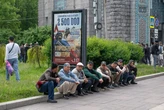When Connor Hovey began talking to his co-workers at Trader Joe’s in Louisville about forming a union, he knew it wouldn’t be easy. What he didn’t expect was that the campaign would transform from a marathon into a race without a finish line.
Two years after Hovey and his co-workers won a union election in Louisville, their fight for union representation remains in limbo. The grocery chain with a progressive reputation filed six objections with the National Labor Relations Board after workers voted 48 to 36 to join Trader Joe’s United, an independent union. Every objection was tossed twice—first by an NLRB hearing officer and later by a regional director. But last month, the workers’ path to certification stalled again when President Donald Trump abruptly fired Gwynne Wilcox, a Biden appointee, leaving the board unable to rule on the company’s final appeal.
The board’s paralysis has prevented thousands of workers like Hovey from seeking redress from an agency whose very mission is to enforce worker rights, while providing employers with new opportunities to stall disputes. At the same time, the lack of a functioning arbiter of labor relations has left workers and their advocates wondering if the time has come to employ more confrontational tactics in labor disputes.
“It became clear the NLRB was already underfunded, understaffed, and overworked,” said Hovey. “Now [with the freeze] we may not have a decision on our election for several more years.”
Catherine Creighton is a former National Labor Relations Board attorney now at Cornell University’s School of Industrial and Labor Relations. Without a functioning board, she said, “You can organize, but if the employer doesn’t agree to recognize the union or bargain, there’s nothing you can do about it. For workers, there’s nowhere you can go.”
Trump’s firing of Wilcox, whose term was not due to expire until 2028, represented an extraordinary assertion of executive power over an independent agency; on the same day, Trump fired two commissioners on the Equal Employment Opportunity Commission, leaving that agency, too, without a working quorum. (Wilcox has since filed a lawsuit contesting her firing, arguing that it violated some of the very labor laws she previously enforced.) The freeze at the National Labor Relations Board comes while attorneys for Elon Musk’s SpaceX and Jeff Bezos’ Amazon, which are both facing labor complaints, argue in federal court that the NLRB is unconstitutional, in part because it impedes executive power. Attorneys for Trader Joe’s have also asserted, in NLRB proceedings, the unconstitutionality of the NLRB.
Spokespersons for the National Labor Relations Board did not respond to queries about the number of cases currently frozen at the board, though last year the board issued 372 decisions. Amazon has at least eight cases pending at the board, including an appeal of a judge’s decision ordering a new election at a 6,100-employee warehouse in Bessemer, Alabama, due to numerous labor law violations the company committed during a 2022 campaign. In January, the NLRB reported that the board was hearing 62 separate cases in which administrative law judges had determined Starbucks had broken labor laws. Along with contesting the Louisville election, Trader Joe’s is appealing a judge’s finding that the company threatened workers and froze wages at two unionized stores.
The lack of a functioning board will exacerbate the backlog of cases at the NLRB, said Caren Sencer, a labor lawyer with Weinberg, Roger & Rosenfeld who represents multiple unions whose cases are now stalled at the National Labor Relations Board. “It already felt indefinite,” she said about the slow pace of NLRB proceedings. “Now it actually is.”
The current NLRB paralysis affects cases that have reached the board, not those at lower levels. But it does provide new motivation for employers to appeal lower-level cases, since they know that without a quorum the case will eventually stall out. The lack of a quorum can also open up new avenues for objections. This happened recently in Philadelphia, where, for the first time, Whole Foods workers voted to unionize on Jan. 27, the same day Trump fired Wilcox. Attorneys for Whole Foods, which is owned by Amazon, filed objections to the results, asserting among their complaints that the election wasn’t viable without a quorum at the board.
For Creighton, of Cornell University, the lack of a quorum renews an age-old debate among labor: Is it worth trying to organize within the slow-moving NLRB? “Why go into enemy territory?” she asked. “It was the only game in town, but now it’s nothing.” She said that workers and unions, faced with a nonfunctioning or hostile board, may increasingly choose tactics like strikes to get what they want. In her departing statement, former National Labor Relations Board General Counsel Jennifer Abruzzo, a staunchly pro-labor figure, hinted as much, writing that if the agency doesn’t protect workers’ rights, she expects workers “will take matters into their own hands.”
Hovey, the Trader Joe’s worker in Louisville, has come to a similar conclusion after several years of union organizing. “It’s important to recognize that direct action is the only way to receive the benefits you’re looking for. You can’t depend on a government agency.”
— Gabriel Thompson, Capital and Main
This piece was originally published by Capital & Main, which reports from California on economic, political, and social issues.








No comments